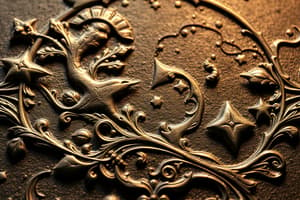Podcast
Questions and Answers
What is the primary method used in forging to shape metal?
What is the primary method used in forging to shape metal?
- Hammering or compressing (correct)
- Cutting with rotary cutters
- Heating
- Pouring
Which metalworking technique involves embedding materials into the surface of jewelry?
Which metalworking technique involves embedding materials into the surface of jewelry?
- Etching
- Casting
- Inlaying (correct)
- Soldering
What is a key characteristic of balance in jewelry design?
What is a key characteristic of balance in jewelry design?
- It disregards visual weight
- It can involve both symmetry and asymmetry (correct)
- It requires symmetry only
- Only formal balance is used
Which technique is primarily used to create shapes by removing material from a metal block?
Which technique is primarily used to create shapes by removing material from a metal block?
How does contrast enhance jewelry design?
How does contrast enhance jewelry design?
Which metalworking technique involves pouring molten metal into a mold?
Which metalworking technique involves pouring molten metal into a mold?
What does color theory primarily help with in jewelry design?
What does color theory primarily help with in jewelry design?
What is the main goal of considering functionality in jewelry design?
What is the main goal of considering functionality in jewelry design?
Flashcards are hidden until you start studying
Study Notes
Metalworking Techniques
-
Forging
- Shaping metal through hammering or compressing.
- Increases strength and alters the metal's grain structure.
-
Soldering
- Joining two metal pieces using a filler metal with a lower melting point.
- Common methods: hard soldering and soft soldering.
-
Casting
- Pouring molten metal into a mold to create a shape.
- Types: investment casting, sand casting, and lost-wax casting.
-
Milling
- Removing material from a solid block of metal using rotary cutters.
- Creates precise shapes and details.
-
Etching
- Using acid or chemicals to carve designs into the metal surface.
- Produces intricate patterns and textures.
-
Inlaying
- Embedding materials (like gemstones or other metals) into the surface of the jewelry.
- Enhances visual appeal and adds depth.
Jewelry Design Principles
-
Balance
- Distribution of visual weight in the piece.
- Achieved through symmetry (formal balance) or asymmetry (informal balance).
-
Proportion
- Relationship between the size of different elements in the jewelry.
- Important for ensuring harmony and aesthetic appeal.
-
Contrast
- Use of opposing elements (e.g., light vs. dark, smooth vs. textured) to create visual interest.
- Highlights specific features of the design.
-
Repetition
- Reusing elements or motifs throughout the piece for cohesion.
- Creates rhythm and unity in the design.
-
Color Theory
- Understanding how colors interact and complement each other.
- Important for selecting gemstones and metal finishes.
-
Functionality
- Consideration of how the jewelry will be worn or used.
- Ensures comfort and practicality without sacrificing aesthetics.
Metalworking Techniques
-
Forging
- Enhances metal strength by shaping it through hammering or compression.
- Alters the grain structure of metals for improved durability.
-
Soldering
- Joins two metal pieces using a low melting point filler metal.
- Methods include hard soldering (stronger joints) and soft soldering (more flexible joints).
-
Casting
- Involves pouring molten metal into molds to form specific shapes.
- Common casting methods:
- Investment casting: Uses wax models for intricate details.
- Sand casting: Utilizes sand molds for a range of shapes.
- Lost-wax casting: An ancient technique for fine details and complexity.
-
Milling
- Removes material from solid metal blocks using rotating cutters.
- Allows the creation of precise shapes and adds intricate details to the design.
-
Etching
- Employs acids or chemicals to engrave designs onto metal surfaces.
- Capable of producing detailed patterns and textures on jewelry.
-
Inlaying
- Involves embedding various materials, such as gemstones or metals, into the surface of jewelry.
- A technique that enhances visual appeal and adds depth to the design.
Jewelry Design Principles
-
Balance
- Achieves visual equilibrium through symmetry (formal) or asymmetry (informal).
- Critical for aesthetic appeal and overall harmony in jewelry pieces.
-
Proportion
- Refers to the size relationships among different elements in the piece.
- Ensures a harmonious look and enhances the craftsmanship of the design.
-
Contrast
- Utilizes opposing elements, such as light vs. dark or smooth vs. textured, for added visual complexity.
- Helps to highlight specific features within the jewelry design.
-
Repetition
- Reuses elements or motifs throughout the piece, creating a sense of cohesion.
- Establishes rhythm and unity, making the design more visually engaging.
-
Color Theory
- Analyzes interactions and complements among colors in design.
- A vital aspect for selecting suitable gemstones and metal finishes that enhance the overall aesthetic.
-
Functionality
- Considers how users will wear or utilize the jewelry.
- Balances comfort and practicality with aesthetic considerations, ensuring a wearable and appealing piece.
Studying That Suits You
Use AI to generate personalized quizzes and flashcards to suit your learning preferences.





